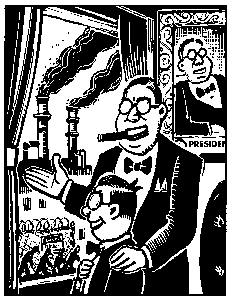
Kuper calls his book 'Eye of the Beholder' because it's up to the reader to connect the dots in the story.
Peter Kuper's 'Eye of the Beholder' cracks the good, gray 'NY Times'
TO HAVE DONE the unthinkable--to have broached the good, gray New York Times' embargo on comics--is no mean feat. Peter Kuper has done it in Eye of the Beholder (collected by Nantier, Beall, and Minoustchine, $8.95), and he's done it at a time when newspaper strips are uniformly mediocre.
Kuper's work is of the school of Käthe Kollwitz and Lynd Ward, the latter known for his 1920s-era woodcut wordless novel God's Man. A deeply talented graphic artist out of Cleveland, Kuper's very personal autobiographical comics about his youth there (issued in Bleeding Heart comics, and collected in Stripped! by Fantagraphics) are among the best work done in this fruitful genre.
Kuper has also had some success as a graphic artist, having done the cover of Time magazine in another style he uses frequently: a deliberately coarse-grained airbrushing that looks like a painstakingly delicate spray painting.
Eye of the Beholder is a dialogue-free series of five panels. As printed in Eye of the Beholder, the comic appears in a sequence on four small panels with the grabber on the reverse page blown up to full size. His pictures can be summed up in 10 words, if not a thousand: "People at an ATM," "Delusions of a Madman," "A Gorilla's-Eye View of a Zoo Crowd" and other commentary on the cruelties of urban life.
I share Kuper's politics and at the same time still think the book is occasionally heavy-handed. There are 44 cartoons, and only five of them are about the homeless--not a big number, but why does homelessness seem like a cliché here? The problem may be in characterization. Kuper's generic wistful gray-faced, bearded man--even necessarily made an archetype for clearer understanding of this dialogue-free comic--made me feel as if I'd seen a racial stereotype.
The homeless in real life come in a variety of styles--some pitiful, some raving mad, some comic, some frightening, some wobbling drunk--and I think you can portray them other than as saintly.
The best of the cartoons on the subject of the homeless establishes Kuper's real theme. In four panels, a baby chick evolves into a roast-chicken dinner; as its last stop, it becomes a drumstick bone that Kuper's Homeless Man has salvaged from a dumpster.
A similar series consists of four panels of turn-of-the-last-century civic elegance becoming a modern horror cityscape viewed by a doddering old man. It's like The Magnificent Ambersons in five-panel comic form; Welles was a cartoonist, too. In yet another drawing, a new car that ends up stolen, stripped and eventually crushed for scrap. The real motif in The Eye of the Beholder is the same horror of decay that made Expressionist art so vivid.
KUPER CALLS his book Eye of the Beholder because it's up to the reader to connect the dots in the story. Kuper's skill as a cartoonist lies in our imagination of what goes on between the panels. The dollar-bill's-eye in the pyramid that turns up as a logo and on the end papers of Eye of the Beholder suggests the God's-eye view of the reader of the book.
In 1994, Kuper published the anthology Different Beat (Fantagraphics, $3.50). It too had the Eye, in a mute piece titled "In God We Trust" of a silk-hatted millionaire abusing the Eye in the Pyramid, finally blinding it with his cane (a way, I suppose of saying, "Even God doesn't see what goes on in America").
In low moments, I sympathize, but the best things in Eye of The Beholder are not the straight political commentary but Kuper's more comic work. A portly boss shows off his Expressionist hell-factory to his little princeling, an miniature twin of the plutocrat. The old man is making a gesture that says, 'Someday, this will all be yours.'
The look of carnal delight in the horrid little son's face is Kuper at his sharpest, and it is satisfying to think of it being in the New York Times--even if the target of the jape is probably reading the editorials in the Wall St. Journal.
[ Metro | Metroactive Central | Archives ]
![[Metroactive Books]](/books/gifs/books468.gif)